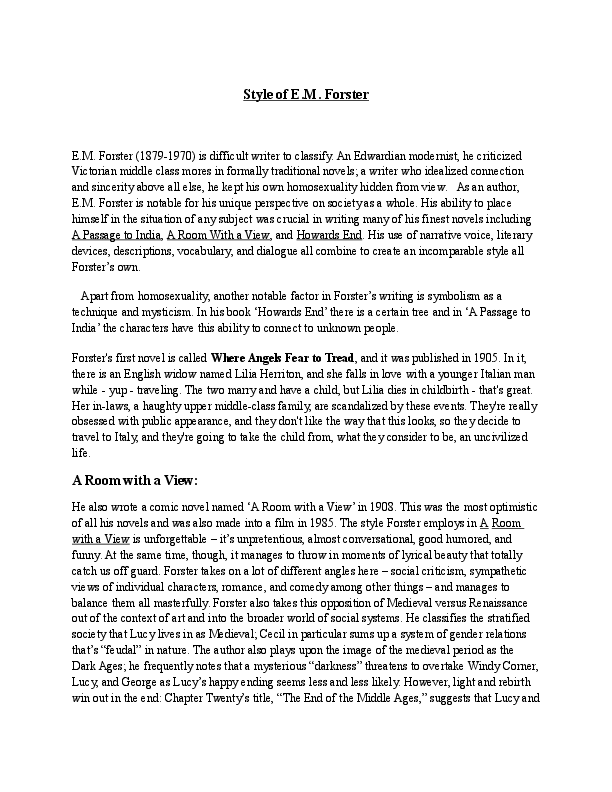Academia.edu no longer supports Internet Explorer.
To browse Academia.edu and the wider internet faster and more securely, please take a few seconds to upgrade your browser.
Style of E.M. Forster
Related Papers
Okara: Jurnal Bahasa dan Sastra
Edward Morgan Forster and His Aspects of the Novel2013 •
Aspects of the Novel is the publication of a series of lectures on the English Language novel delivered by E.M. Forster. These lectures presents the seven aspects, Forster believes, should include in the novel. Those seven aspects are story, people, plot, fantasy and prophecy, pattern and rhythm. This article is elaborating those seven aspects along with the explanation. It is expected that after reading Forster’s lectures, people will get a better insight towards the form of a good novel.
Routledge Companion to Philosophy of Literature
Literary style (in: Routledge Companion to Philosophy of Literature, ed. by Noël Carroll and John Gibson, London/New York, 2016)Essays in Criticism
Concerning E. M. Forster. By Frank Kermode. "Forster and Fiction". (review essay)2011 •
Language and Literary Studies of Warsaw
Adaptation, Inspiration, Dialogue: E. M. Forster and His Oeuvre in Contemporary Culture2020 •
The article aims at charting the position of Edward Morgan Forster and his works in contemporary English language culture. It presents various forms of adaptations of or responses to the works of Forster, concentrating on those which have been created since the writer's death in 1970. The discussed material consists of approximately one hundred instances of various works of art related in a number of ways to Forster's oeuvre and biography: adaptations, works inspired by Forster's oeuvre or biography, and, finally, works which enter into a dialogue with Forster and his views. Radio plays, operas, plays, movies, musicals, comic books, concept albums, etc. have been included as well. The paper also touches upon Forster's reception among scholars and in political journalism. The paper is supplemented with lists of various adaptations. The two files are draft with links to sources and the official published text.
Polish Journal of English Studies
E. M. Forster: A Bibliography of Critical Studies2021 •
Bibliography of Critical Studies in the works of E. M. Forster - published in the Polish Journal of English Studies 7.2/2021 - covering the period 1975-2021
2010 •
"The volume intended to commemorate the 40th anniversary of E. M. Forster's death. It consists of ten papers by various authors which deal with various aspects of Forster's oeuvre, creating a new overview of his works from his novels, through his essays to his only opera libretto. List of Contents Anna Kwiatkowska - Ironic Reflections on Life: E. M. Forster’s Novels and Henri Bergson’s Philosophy of Laughter Paweł Wojtas - E. M. Forster’s Uneasy Bildungsroman: Exploring the Meanders of Existential Aporias in The Longest Journey Krzysztof Kramarz - Deletion, Metaphor and Footnote: the Analysis of Polish Translations of A Room with a View Tomasz Dobrogoszcz - A Passage to OU-BOUM – Homi Bhabha reads E. M. Forster Krzysztof Fordoński - E. M. Forster’s Geography of Homosexual Desire Piotr Urbański - “The love that passes understanding has come to me” – Remarks on Staging Billy Budd Heiko Zimmermann - Teaching E. M. Forster in 2010 – Essayistic Reflections Krzysztof Fordoński - Polish Aspects of E. M. Forster – A Postscript From the cover - an excerpt from review "This collection of essays edited by Krzysztof Fordoński, a renowned specialist in E.M. Forster’s novels, is devoted to various aspects of Forster’s literary output and undoubtedly will be a landmark publication. The book successfully presents all the major issues important in Forster’s works for the contemporary reader: cultural differences, existential and aesthetic problems, varieties of sexual desire, educational challenges. These aspects are discussed from the viewpoint of postcolonial, gender, translation, educational, and cultural studies. This volume should be easily accessible to a wider, international audience, readers who enjoy Forster’s novels and are interested in learning about a variety of issues associated with his life and works." Prof. Piotr Wilczek, Institute for Interdisciplinary Studies „Artes Liberales”, University of Warsaw"
RELATED PAPERS
Zbornik Lovranšćine
Prilog poznavanju povijesti liburnijskoga planinarstva2022 •
Mustafa Imamović’in Boşnakların Tarihi (Historija Bošnjaka) Adlı Kitabı ve Türkçe Tercümesine Dair Tespit ve Değerlendirmeler
Mustafa Imamović'in Boşnakların Tarihi (Historija Bošnjaka) Adlı Kitabı ve Türkçe Tercümesine Dair Tespit ve Değerlendirmeler2020 •
2018 •
The International Journal of Advanced Manufacturing Technology
Process-guided coordinate sampling of end-milled flat plates2010 •
2021 •
Journal of Global Innovations in Agricultural and Social Sciences )
Antioxidant and Anti-Hemolytic Activities of Phenolic Constituents of Six Moroccan Date Fruit (Phoenix Dactylifera L.) Syrups2015 •
Journal of Public Health Management and Practice
The Influence of Management and Environment on Local Health Department Organizational Structure and Adaptation2013 •
2018 •
The Journal of Religion
Virginia Nixon, . Mary’s Mother: Saint Anne in Late Medieval Europe. University Park: Pennsylvania State University Press, 2004. xiii+216 pp. $35.00 (cloth)2006 •
Frontiers in Medicine
Effect of Point Spread Function Deconvolution in Reconstruction of Brain 18F-FDG PET Images on the Diagnostic Thinking Efficacy in Alzheimer's Disease2021 •
Topoi-an International Review of Philosophy
Finance, Nature and Ontology2019 •


 Umama Shah
Umama Shah